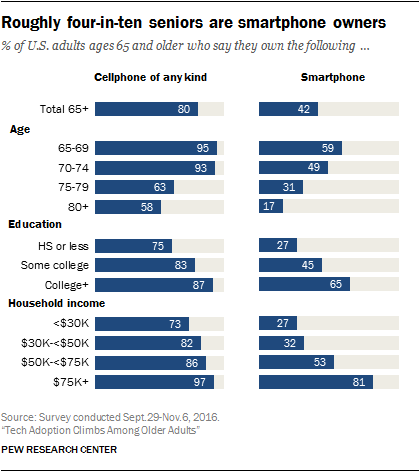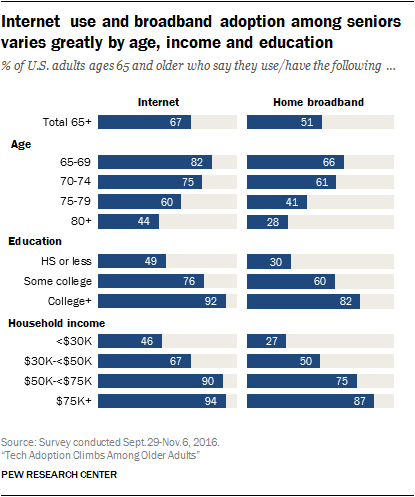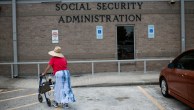Although seniors consistently have lower rates of technology adoption than the general public, this group is more digitally connected than ever. In fact, some groups of seniors – such as those who are younger, more affluent and more highly educated – report owning and using various technologies at rates similar to adults under the age of 65.
Still, there remains a notable digital divide between younger and older Americans. And many seniors who are older, less affluent or with lower levels of educational attainment continue to have a distant relationship with digital technology.
Four-in-ten seniors now own smartphones, more than double the share that did so in 2013

With smartphone ownership in the U.S. more than doubling in the past five years, Americans are embracing mobile technology at a rapid pace. And while adoption rates among seniors continue to trail those of the overall population, the share of adults ages 65 and up who own smartphones has risen 24 percentage points (from 18% to 42%) since 2013. Today, roughly half of older adults who own cellphones have some type of smartphone; in 2013, that share was just 23%.
Smartphone ownership among seniors varies substantially by age: 59% of 65- to 69-year-olds own smartphones, but that share falls to 49% among 70- to 74-year-olds. Smartphone adoption drops off considerably among adults in their mid-70s and beyond. Some 31% of 75- to 79-year-olds say they own smartphones, while only 17% of those ages 80 and older are smartphone owners.

Smartphone ownership is also highly correlated with household income and educational attainment. Fully 81% of older Americans whose annual household income is $75,000 or more say they own smartphones, compared with 27% of those living in households earning less than $30,000 a year. Additionally, around two-thirds of seniors with bachelor’s or advanced degrees report owning smartphones (65%), compared with 45% of those who have some college experience and 27% of those who have high school diplomas or less.
Seniors in these high-adoption groups have seen the largest growth in smartphone ownership in recent years. Since 2013, smartphone adoption among older adults who live in households earning $75,000 or more a year has increased by 39 percentage points; those with at least bachelor’s degrees, as well as those who are ages 65 to 69, have each seen a 30-point increase in smartphone adoption over that time.
Internet use and broadband adoption among seniors varies across demographic groups

As is true of the population as a whole, internet adoption among seniors has risen steadily over the last decade and a half. When the Center began tracking internet adoption in early 2000, just 14% of seniors were internet users. But today, 67% of adults ages 65 and older say they go online.
The share of seniors who subscribe to home broadband services has also risen – albeit at a slower rate than internet use. Around half of seniors (51%) now say they have high-speed internet at home. This represents a modest uptick from 2013, when 47% of older adults were broadband adopters.
As is true of the general public, internet and broadband adoption among older adults varies substantially across a number of demographic factors – most notably age, household income and educational attainment.
Younger seniors use the internet and subscribe to home broadband at rates that are comparable to the overall population. Fully 82% of 65- to 69-year-olds are internet users, and two-thirds say they have broadband internet connections at home. (Internet use and broadband adoption rates for the overall population are 90% and 73%, respectively).
On the other hand, fewer than half of seniors ages 80 and up (44%) report using the internet and just 28% say they have home broadband service. Adoption rates for seniors in their 70s fall in between these two groups.
Internet and broadband adoption rates also differ considerably by household income and educational attainment. Around nine-in-ten seniors whose annual household income is $75,000 or more say they go online (94%) or have high-speed internet at home (87%). Those shares drop to 46% and 27%, respectively, among older adults living in households earning less than $30,000 a year. College graduates are far more likely than those with high school educations or less to say they use the internet (92% vs. 49%) or have home broadband service (82% vs. 30%).
Tablet ownership grows among older Americans, while e-reader adoption stalls

Roughly one-third (32%) of seniors say they own tablet computers, while about one-in-five (19%) report owning e-readers. While this represents a double-digit increase in tablet ownership since 2013, the share of older Americans who own e-readers has stayed largely unchanged over that time period. (This mirrors adoption trends in the broader population as well).
Tablet ownership is especially common among seniors with more education and those living in higher-income households. Some 62% of older adults with annual household incomes of $75,000 or more say they own tablet computers, while 56% of college-degree earners say the same. Each represents a more than 20-point increase since 2013 (at that point, 39% of high-income seniors and 31% of college graduates in this age group owned tablets).
By comparison, fewer than one-in-five seniors in households earning less than $30,000 a year (16%) or who have high school diplomas or less (18%) own tablets. E-reader adoption follows a similar pattern, albeit from a lower baseline level of overall ownership.
Younger seniors are also more likely than their older counterparts to own tablets or e-readers, although these differences are especially pronounced in the case of tablets. Some 41% of 65- to 69-year-olds report having tablet computers, compared with 20% of those ages 80 and older. The age gap in e-reader ownership is narrower: 21% of 65-to 69-year-olds and 13% of those ages 80 and older are e-reader owners.
Social media use among older Americans steadily increases

Social media is increasingly becoming an important platform where people find news and information, share their experiences and connect with friends and family. And just as internet adoption and smartphone ownership has grown among seniors, so has social media use.
Today, 34% of Americans ages 65 and up say they ever use social networking sites like Facebook or Twitter. This represents a seven-point increase from 2013, when 27% of older adults reported using social media. Still, a majority of seniors do not use social media, and the share that do is considerably smaller than that of the general population.
As with other forms of digital technology, younger seniors are more likely than their older counterparts to use social media. More than four-in-ten (45%) seniors under the age of 75 say they ever use social networking sites, compared with 20% of those ages 75 and older. Social networking use is also relatively common among those who have at least some college experience and those whose annual household income is $50,000 or more.




